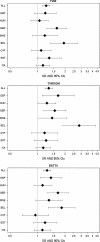Television habits in relation to overweight, diet and taste preferences in European children: the IDEFICS study
- PMID: 22911022
- PMCID: PMC3486991
- DOI: 10.1007/s10654-012-9718-2
Television habits in relation to overweight, diet and taste preferences in European children: the IDEFICS study
Abstract
Early television exposure has been associated with various health outcomes including childhood obesity. This paper describes associations between patterns of television viewing, on one hand, and diet, taste preference and weight status, on the other, in European preschoolers and schoolchildren. The IDEFICS baseline survey was conducted at examination centers in Italy, Estonia, Cyprus, Belgium, Sweden, Germany, Hungary, and Spain. 15,144 children aged 2-9 completed the basic protocol, including anthropometry and parental questionnaires on their diets and television habits. A subsample of 1,696 schoolchildren underwent further sensory testing for fat and sweet taste preferences. Three dichotomous indicators described: children's habitual television exposure time; television viewing during meals; and having televisions in their bedrooms. Based on these variables we investigated television habits in relation to overweight (IOTF) and usual consumption of foods high in fat and sugar. A possible role of taste preference in the latter association was tested in the sensory subgroup. All television indicators were significantly associated with increased risk of overweight, with odds ratios ranging from 1.21 to 1.30, in fully adjusted models. Children's propensities to consume high-fat and high-sugar foods were positively and, in most analyses, monotonically associated with high-risk television behaviors. The associations between television and diet propensities were not explained by preference for added fat or sugar in test foods. To summarize, in addition to being more overweight, children with high-risk television behaviors may, independent of objectively measured taste preferences for fat and sugar, passively overconsume higher-fat and particularly higher-sugar diets.
Figures

References
-
- Commonwealth of Australia. Healthy Eating and Physical activity Guidelines for Early Childhood Settings. 2009.
-
- Dietz WH, Gortmaker SL. Do we fatten our children at the television set? Obesity and television viewing in children and adolescents. Pediatrics. 1985;75:807–812. - PubMed
Publication types
MeSH terms
Substances
LinkOut - more resources
Full Text Sources
Medical

